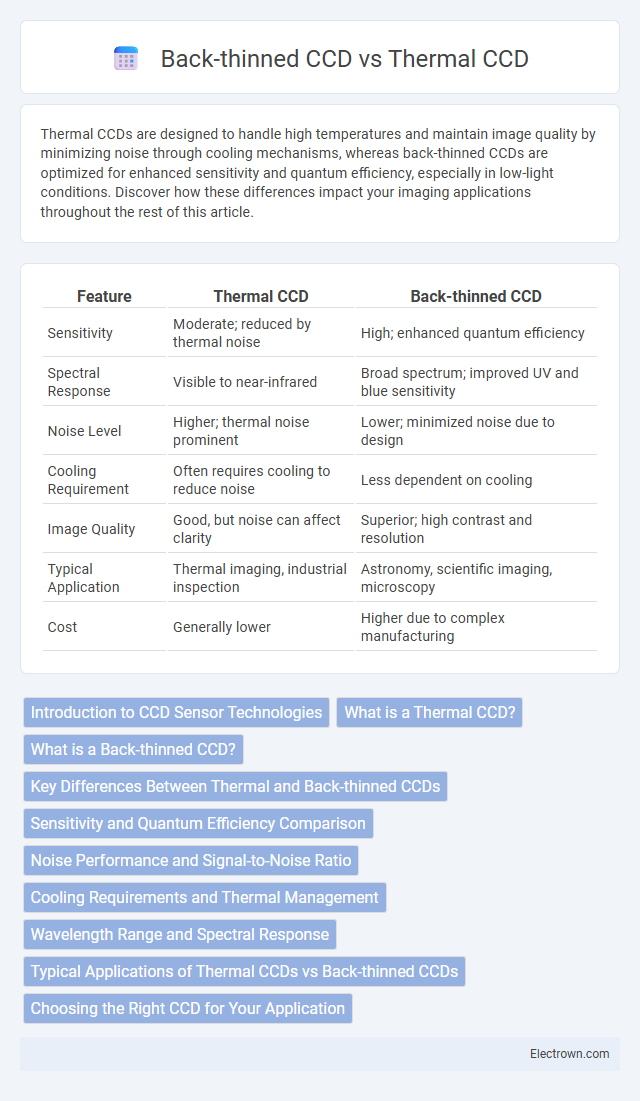Thermal CCDs are designed to handle high temperatures and maintain image quality by minimizing noise through cooling mechanisms, whereas back-thinned CCDs are optimized for enhanced sensitivity and quantum efficiency, especially in low-light conditions. Discover how these differences impact your imaging applications throughout the rest of this article.
Table of Comparison
| Feature | Thermal CCD | Back-thinned CCD |
|---|---|---|
| Sensitivity | Moderate; reduced by thermal noise | High; enhanced quantum efficiency |
| Spectral Response | Visible to near-infrared | Broad spectrum; improved UV and blue sensitivity |
| Noise Level | Higher; thermal noise prominent | Lower; minimized noise due to design |
| Cooling Requirement | Often requires cooling to reduce noise | Less dependent on cooling |
| Image Quality | Good, but noise can affect clarity | Superior; high contrast and resolution |
| Typical Application | Thermal imaging, industrial inspection | Astronomy, scientific imaging, microscopy |
| Cost | Generally lower | Higher due to complex manufacturing |
Introduction to CCD Sensor Technologies
Thermal CCD sensors are designed to detect infrared radiation by converting temperature variations into electronic signals, making them ideal for applications requiring heat mapping and night vision. Back-thinned CCD sensors, on the other hand, feature a thinned silicon substrate that enhances their quantum efficiency and sensitivity to visible light, benefiting low-light imaging and scientific research. Your choice between thermal and back-thinned CCD technologies depends on the specific imaging requirements, such as spectral range and sensitivity.
What is a Thermal CCD?
A Thermal CCD is a type of charge-coupled device designed to detect infrared radiation by converting heat energy into electronic signals, enabling imaging in low-light and thermal environments. Unlike back-thinned CCDs, which are optimized for enhanced sensitivity to visible light through a thin, transparent substrate, Thermal CCDs focus on capturing temperature variations for applications like night vision and thermal analysis. Your choice of sensor depends on whether you prioritize infrared thermal detection or visible light sensitivity.
What is a Back-thinned CCD?
A Back-thinned CCD is an advanced type of charge-coupled device sensor designed with a thinned silicon substrate to enhance quantum efficiency by allowing more light to reach the photoactive region. Unlike thermal CCDs, which operate at elevated temperatures and are optimized for infrared detection, back-thinned CCDs excel in visible and ultraviolet light sensitivity due to reduced photon absorption before reaching the sensor. Your imaging applications benefit from improved low-light performance and higher signal-to-noise ratio when using back-thinned CCD technology.
Key Differences Between Thermal and Back-thinned CCDs
Thermal CCDs are designed to operate at higher temperatures by minimizing noise through integrated cooling, making them ideal for infrared imaging where thermal effects impact performance. Back-thinned CCDs feature a thinned silicon substrate allowing for increased quantum efficiency and enhanced sensitivity, particularly in low-light and scientific applications. Your choice depends on whether thermal management or maximum photon detection efficiency is critical for your imaging needs.
Sensitivity and Quantum Efficiency Comparison
Thermal CCDs exhibit lower sensitivity and quantum efficiency due to increased noise from thermal electrons, limiting their performance in low-light conditions. Back-thinned CCDs achieve high quantum efficiency, often exceeding 90%, by minimizing absorption losses and enhancing photon capture on the sensor's active surface. This makes back-thinned CCDs optimal for applications requiring superior sensitivity and accurate low-light imaging.
Noise Performance and Signal-to-Noise Ratio
Thermal CCD sensors exhibit higher noise levels due to increased dark current, which degrades the signal-to-noise ratio (SNR) compared to back-thinned CCDs optimized for low-light performance. Back-thinned CCDs, with their enhanced quantum efficiency and reduced noise floor, deliver superior SNR by maximizing photon collection and minimizing electron trapping. This makes back-thinned CCDs the preferred choice for applications demanding high sensitivity and precise low-noise imaging.
Cooling Requirements and Thermal Management
Thermal CCDs require robust cooling systems, such as thermoelectric coolers or liquid nitrogen, to reduce sensor noise caused by heat during long exposures, ensuring optimal image quality. Back-thinned CCDs, with their thinner silicon layers, generate less heat and often demand less intensive cooling, improving thermal management efficiency in compact setups. Your choice between these sensors should consider the cooling infrastructure needed to maintain performance and reduce thermal noise in your imaging applications.
Wavelength Range and Spectral Response
Thermal CCDs primarily detect infrared wavelengths, making them ideal for applications requiring thermal imaging and temperature mapping within the mid to long-wave infrared spectrum. Back-thinned CCDs offer superior spectral response across the visible to near-ultraviolet range, thanks to their enhanced quantum efficiency and reduced photon absorption through the thinning process. Your choice between these sensors should consider the specific wavelength range and spectral sensitivity required for accurate detection and imaging.
Typical Applications of Thermal CCDs vs Back-thinned CCDs
Thermal CCDs are typically used in industrial inspection, medical imaging, and scientific research where capturing images in low-light or high-temperature environments is crucial. Back-thinned CCDs excel in astronomy, fluorescence microscopy, and low-light photography due to their higher quantum efficiency and improved sensitivity. Your choice depends on whether you require enhanced thermal detection or superior light sensitivity for precise imaging applications.
Choosing the Right CCD for Your Application
Thermal CCDs excel in high-temperature environments, offering robust performance with minimal noise, making them ideal for industrial inspections and harsh settings. Back-thinned CCDs provide superior quantum efficiency and sensitivity, especially in low-light and scientific imaging applications, due to their enhanced photon absorption. Selecting the right CCD depends on application-specific requirements like environmental conditions, light sensitivity, and image resolution needs.
Thermal CCD vs Back-thinned CCD Infographic

 electrown.com
electrown.com